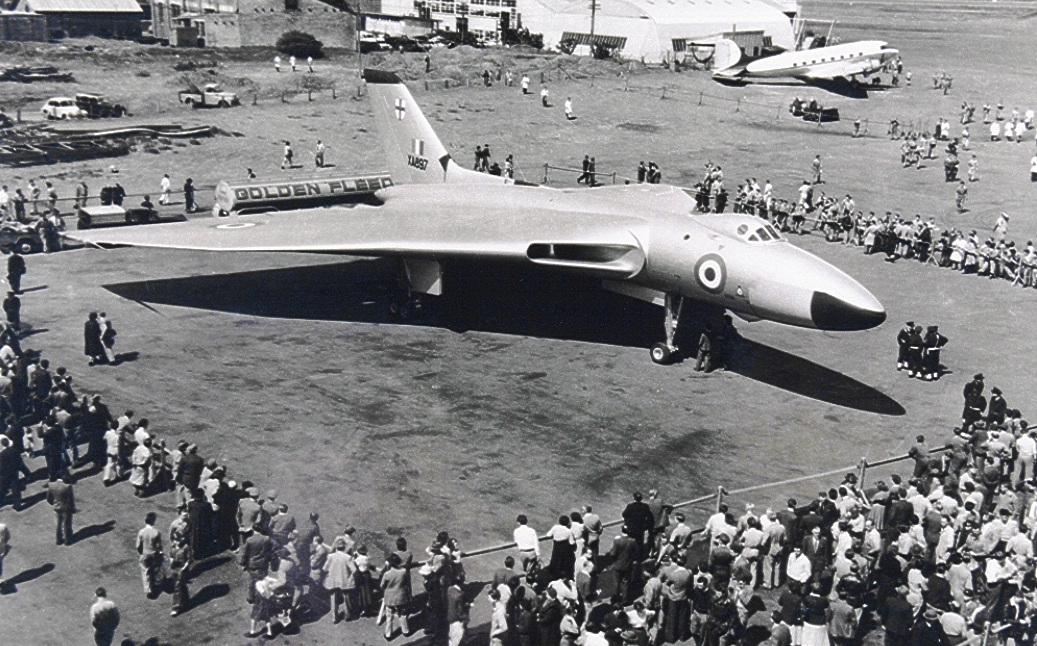The Vulcan
surely one of the most remarkable aircraft ever built the Second World War
influenced in their research and design.
The
aircraft was Avro’s futuristic and adventurous response to a 1946 Air Ministry Operational
Requirement calling for a bomber able to carry a 4540kg / 10009lb atomic bomb
to a target 2775km / 1725 miles away.
The Avro
type 698 was conceived as a high altitude atomic bomber, and was the firs four engine
delta wing aircraft. The unconventional wing shape was chosen because it combines
good load carrying capabilities and high subsonic speed at altitude. To help
gain data for the radical new design several “mini Vulcans” research aircraft
were built the Avro type 707s. Gradually the design was changed before the well
known Vulcan layout was finalized. What had been a flying wing with wingtip
fins acquired a single central fin, the nose was extended and a distinct
fuselage section evolved.
The
prototype VX770 flew in August 1952, piloted by Wing Commander Roly Falk and in
1953 the type 698 was officially named the Vulcan. Spectacular Farnborough
appearances followed the most amazing being a full roll at the 1955 show.
After a
redesign of the wing and the additional of more powerful engines, the Vulcan
B.1 entered RAF service in February 1957, and became operational with No.83
Squadron at Waddington in July of the same year.
Britain’s nuclear deterrent force had to be
effective and hard hitting and it became clear that the B.1 was increasingly
vulnerable to the improved Soviet defences it would have to overcome if it were
to strike deep into the Soviet Union. To
increase the chances of the RAF crews reaching their objectives, the Vulcan B.2
was proposed with more powerful engines an electronic warfare (ECM) suite in an
enlarged tail cone and an in-flight refuelling capability along with an
improved larger wing. Some B.1s had a few B.2 improvements incorporated and were
designated B.1As. With a longer range the ability to carry a heavier bomb load
(two nuclear weapons instead of one) and greatly improved self defence
capability the B.2 ensured that the British nuclear strike forces was a very
real threat to the Soviet Union.
Even with
the new and improved B.2 the delivery of free fall nuclear weapons into the
heart of the Soviet Union was probably still a
one way ticket for Vulcan crews. To improve their survivability a stand off
nuclear missile the Blue Steel was developed, which could be launched 161km / 100 miles away from the
target. Blue Steel was carried partially recessed in the Vulcan’s modified bomb
bay.
However it
was with conventional weapons that the Vulcan first went to war in 1982 when it
was used against Argentine positions on the Falkland
Islands (Islas Malvinas) in what were then the longest bombing
raids in history. Vulcans also served in strategic reconnaissance and air
refuelling tanker roles before being withdrawn from service in1984 to be
replaced by Tornadoes. Avro built 144 Vulcans in total a small number
considering the impact that the design had on the aerospace world and the
affection felt for the “tin triangle” by air shows fans the world over.
AVRO VULCAN
B.2A
First
flight: August 30, 1952 (Avro prototype)
Power: Four
Rolls Royce 9080kg / 20000lb thrust Olympus
301 turbojets.
Armament: 21
conventional bombs of 454kg / 1000lb each, nuclear bombs or one Blue Steel
stand off missile.
Size:
Wingspan 33.85m / 111ft.
Length:
30.5m / 99ft 11in.
Height:
8.26m / 27ft 1in.
Wing area:
368m2 / 3964sq ft.
Weight:
Empty 37,682kg / 83,000l.
Maximum take off 113,500Kg /
250,000lb.
Performance:
Maximum speed 1038km/h 645mph.
Ceiling: 16775m /
55,000ft.
Range: 5550km / 3450
miles.







No hay comentarios:
Publicar un comentario